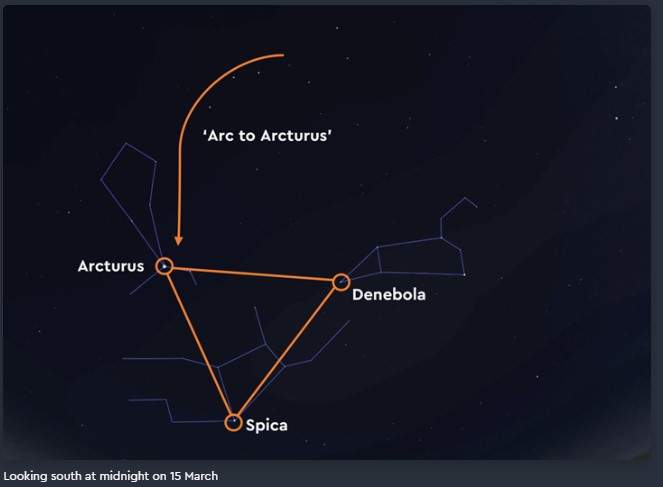Top three things to see in the night sky in March 2024:
– Throughout the month – the spring triangle
– 18 March – Plato crater and other lunar features
– 24 March – Mercury at its greatest distance from the Sun
Spring stars: the Spring Triangle
We’re truly moving into spring now, with the days getting lighter and lighter. The spring equinox on 20 March marks the point where our days and nights are of equal length. From this point forward, for the Northern Hemisphere at least, we’ll have more hours of daylight than night up until the longest day of the year on June 20.
The spring triangle is made up of Arcturus in the constellation of Boötes, Spica in Virgo, and Denebola in Leo. Look towards the southern sky to find these three bright stars.
You could also use the some of the stars in The Plough to ‘arc towards Arcturus’ as shown in the diagram above – tracing the curve of the handle of The Plough and extending the line across the sky should bring you to Arcturus, a distinctive red giant star and the fourth brightest star in the sky. From Arcturus, Denebola will be to the right and Spica below, closer towards the horizon.
Plato Crater on the Moon

The line which marks the boundary between day and night on the Moon (or on any celestial body) is known as the terminator. This area of the Moon is a good target for your telescope if you want to admire some lunar features. The Sun is illuminating these areas from a low angle, meaning mountains, valleys and craters appear more exaggerated.
Try viewing the Moon from 18th March and see if you can find Plato crater to the north of Mare Imbrium. This crater has an incredibly smooth, dark floor within an even and circular crater ring. At 109 kilometres across, you’ll be able to spot this one with binoculars as well as a telescope.
To the right of the Plato Crater you’ll be able to pick out the arc of Montes Alpes, a mountain range with peaks ranging from 1,800 – 2,400 metres above the lunar equivalent of sea level. When these mountains are illuminated from a low angle you’ll see their shadows cast onto the basin of Mare Imbrium.

One of the most challenging planets to find is Mercury, as it’s never too far from the Sun. However this month Mercury will reach its greatest elongation, meaning it’ll be farthest from the Sun it is possible for the planet to reach.
It should be visible in the west in the early evenings from mid-March to early April, with the best evening to spot it being 24 March. If the weather is kind to you and your western horizon is clear, it will be just over 10 degrees above the horizon at 19.00 on this night.
At this point Mercury should be visible to the naked eye, with a magnitude of –0.2. If the weather isn’t favourable to you this time around, you’ve got two more chances in 2024, as it will reach greatest elongation again on 5 September, and again on 25 December.

Full Moon: 25 March (07:00)
Stargazing tips
- When looking at faint objects such as stars, nebulae, the Milky Way and other galaxies it is important to allow your eyes to adapt to the dark so that you can achieve better night vision.
- Allow 15 minutes for your eyes to become sensitive in the dark and remember not to look at your mobile phone or any other bright device when stargazing.
- If you’re using a star app on your phone, switch on the red night vision mode.
— by Jessica Lee, Astronomy Education Officer, Royal Observatory, https://www.rmg.co.uk/stories/blog/astronomy/night-sky-highlights-march-2024


Leave a Reply